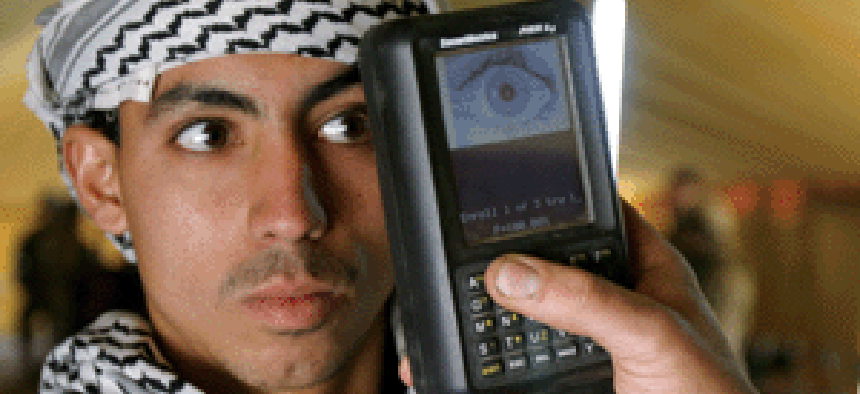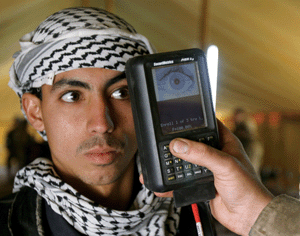TOUCHY SUBJECT

High-profile biometrics contracts such as U.S. Visit, Registered Traveler and the Transportation Workers Identification Credential program grab all the headlines, but they're not where all the money is.
High-profile biometrics contracts such as U.S. Visit, Registered Traveler and the Transportation Workers Identification Credential program grab all the headlines, but they're not where all the money is.Companies see bigger opportunities for biometrics-related work further down the pike."There are plenty of opportunities both from a biometric perspective or an identity management perspective ... beyond U.S. Visit and TWIC," said Jim Ganthier, worldwide leader of defense, intelligence and public safety at Hewlett-Packard Co. Agencies will have to buy more servers and storage capabilities as the use of biometrics increases, he said.Other industry executives said the federal government's spending on biometric integration and consulting services are growing. Worldwide government spending on biometric technologies is expected to grow from $685.9 million in 2005 to nearly $1.8 billion in 2008, according to the International Biometric Group LLC, a biometrics industry consulting firm in New York.The global government sector accounts for more than one-third of total biometrics industry revenue, which will grow from more than $1.8 billion this year to more than $4.6 billion in 2008, according to IBG, which measures only biometric hardware and software sales and not revenue from related professional and integration services.IBG does not break out projected spending for the U.S. government, but said that most biometrics revenue will come from the United States."The ability to produce solutions that are compliant with these [Homeland Security Presidential Directive 12] standards is going to be critical to any company's success," said John Gist, program manager of identity management solutions at Northrop Grumman Information Technology.Northrop Grumman has built a biometrics research and development lab in Reston, Va., to test and showcase its identity management solutions for government agencies. The $5 million Center for Smart Security Solutions, which opened in March 2003, features technology from Northrop Grumman and 35 of its industry partners. So far, more than 5,000 visitors have been to the facility, Gist said.FOLLOW THE DIRECTIVESHomeland Security Presidential Directive 12, known as HSPD-12, is driving many of the biometrics opportunities, corporate executives said. Issued in August 2004, the directive mandates governmentwide identification cards for federal workers and contractors.As a result of the directive, the National Institute of Standards and Technology issued Federal Information Processing Standard 201 (FIPS 201): Personal Identity Verification for Federal Employees and Contractors, which specifies the architecture and technical requirements for a uniform identity credential to access federal facilities and systems. The common ID standard covers biometric data.HSPD-12 "presents a humongous opportunity for all biometrics companies," said Zavi Cohen, president and chief executive officer of Zvetco Biometrics LLC of Orlando, Fla. The small, privately owned network solutions company sells biometrics for secure access control and prevention of identity theft.Zvetco, which focuses mainly on commercial customers, is jumping into the federal government market largely because of the opportunities that HSPD-12 will bring, Cohen said. He said he envisions a 50-50 split in revenue generated by corporate and government customers over the next few years."HSPD-12 and the standard that is involved are good initiatives that will take a long time to implement," he said.Cohen, like others in industry, said he believes that after HSPD-12 is implemented, the government will adopt national identification cards for all citizens, as is being done in other countries. This will create even more biometrics business opportunities.DigitalPersona Inc., which provides user authentication and digital security products and services, such as computer keyboards with biometric fingerprint readers, has developed software solutions for FIPS 201 standards. The software can be used to resolve network access problems as the government works to comply with HSPD-12 over the next two years, said Vance Bjorn, cofounder and chief technology officer of the privately owned Redwood City, Calif., company.With HSPD-12, "every government computer and every government employee needs greater assurance in their identity both for physical access and logical access," he said. "As the FIPS 201 starts to roll out ... we feel we're in a good position to capitalize."Software that manages and fuses different biometric information also may be in demand, said Ben Gianni, vice president of homeland security at Computer Sciences Corp."We're watching what goes on behind the biometric use, because we think that's indicative of a larger shift in the industry toward more risk-based software and more database and customer management-based type software ... for more complex and larger projects and programs," Gianni said.Part of Northrop Grumman's strategy is to use the knowledge the company has gained implementing its own employee biometric ID system, called One Badge, to sell its capabilities to government agencies, Gist said."We use that experience to develop our standards-based interoperable solutions," he said.Because HSPD-12 will require heavy biometric data collection, all government agencies will need more biometric devices and processors for the data, said Nick Orlans, principal engineer at Mitre Corp. Orlans also is chief scientist for the Defense Department's Biometric Fusion Center.Mitre of Bedford, Mass., is a non-profit organization that manages three federally funded research and development centers."There's a lot of opportunity" in operations and management for biometrics, Orlans said.The General Services Administration is putting together a task order for FIPS 201-compliant, 128K smart-card products and supporting components, including biometrics technology. Smart ID cards can authorize access to buildings, computer networks, data files or a user's personal computer.The task order for smart-card technology, which falls under the 10-year, $1.5 billion Smart Card Common ID Card master contract, is still in planning stages. Four prime contractors -- BearingPoint Inc., EDS Corp., Maximus Inc. and Northrop Grumman -- will compete for the task order, which GSA anticipates awarding in January 2006.JUST THE BEGINNINGIn addition to the business opportunities that HSPD-12 will generate, the Defense and Homeland Security departments and other federal agencies are pressing ahead with new biometrics-related projects that companies of all sizes are eager to grab. (See sidebar)Bjorn of DigitalPersona said he expects the federal market to generate about $200 million over the next three years for fingerprint biometrics technologies. The company has rolled out fingerprint-based projects for computer access for some Senate committees, the Office of the Secretary of Defense, some DHS agencies and the Coast Guard, he said.EyeIT.com Inc., Alexandria, Va., has bid on GSA's 10-year, $5 billion Veterans Technology Services contract. The government-wide contract for IT businesses owned by service-disabled veterans focuses on systems operations and maintenance and information systems engineering services. The multiple-award contract will be let in June 2006, according to Input Inc.EyeIT.com is interested in getting task orders for the contract's biometrics work, said Chief Executive Officer Jim Ward. The company integrates, tests and evaluates biometric solutions based on how to incorporate them into architectures. A major customer is the Defense Department, he said."The subcontracting opportunities are really great in the biometric and information assurance areas," Ward said. "A lot of the expertise in biometrics has been held by smaller companies."Once federal agencies have their biometrics projects in place, they will need integration services and software to manage the information collected and to combine biometric data with biographic information, members of industry said."There remains much work to be done and information-sharing and coordination between agencies, not only here in the United States but internationally," CSC's Gianni said.Don Waymire, senior associate and biometric expert at Booz Allen Hamilton Inc. of McLean, Va., said systems integrators and the government have just started to see integration of biometrics into large-scale systems that combine various types of biometric data, such as fingerprints, facial recognition, iris scans and hand geometry."That's really the next generation of the technology," he said.Staff Writer Roseanne Gerin can be reached at rgerin@postnewsweektech.com.XXXSPLITXXX-The feds aren't the only ones spending on biometrics -- the outlook in the state and local market is favorable as well.Zvetco Biometrics LLC, for instance, is looking at state and local governments for biometrics-related opportunities, and has products for logical access that Florida and Maine are evaluating, said Zavi Cohen, Zvetco's president and chief executive officer."The state governments feel a bit more freedom to move as they see fit, whereas the [federal] government market right now is, to an extent, being paralyzed by the Presidential Directive, because everybody is waiting for clarification and for the long-term solution to be spoon-fed to them," Cohen said. Homeland Security Presidential Directive 12 requires all federal agencies to use secure, reliable, common identification standards for their federal workers and contractors.DigitalPersona Inc., which provides fingerprint-based authentication solutions, sees more biometrics-related activities at the state and local government level because it is smaller than the federal government and can move faster in implementing projects, said Vance Bjorn, cofounder and chief technology officer of the Redwood City, Calif., company.State governments are ahead of their federal counterparts in using biometrics-related technology for business applications rather than just security. For example, states are using smart cards to issue benefits, said John Gist, program manager of identity management solutions at Northrop Grumman Information Technology.An example of this is the federal government's Special Supplemental Nutrition Program for Women, Infants and Children, a national program that the states administer, he said.XXXSPLITXXX-The future of biometrics is more than just fingerprint scanners -- that's the message the new director of the Defense Department's Biometrics Management Office wants to send to industry."We're looking for new technologies, innovators and companies that recognize that the biometrics enterprise in the Defense Department and the U.S. government in five years is going to be very different from what we have now," said Joseph Guzman, who was appointed BMO's acting director Aug. 1.Guzman, 44, joined BMO in January as director of policy, planning and liaison. In his new position, he replaces John Woodward Jr., who had been the BMO's director since fall 2003.The office consolidates and coordinates biometric technologies across the Defense Department. The agency uses biometric applications to support warfighters and provide computer-network access control and physical-access control to facilities.By 2010, fingerprint scans will no longer be the predominant biometric technology, Guzman said. In response to Homeland Security Presidential Directive 12, the department will employ a greater amount of biometrics for access control as well as information sharing. The office also is involved in developing standards to support information sharing, he said.Guzman is charged with building up biometrics technologies and ingraining them into Defense Department operations, as well as bringing biometrics closer to the armed forces.BMO runs the Biometric Fusion Center in Clarksburg, W.Va., to test and evaluate commercially available biometric technologies. Including the center, BMO has a $28 million budget.Earlier this year, for instance, BMO provided technical assistance for a pilot demonstration using biometrics for the Military Entrance Processing Command, which determines the physical, mental and moral qualifications of recruits.Fingerprint scans were used to improve processing enlistees. Cross Match Technologies Inc. of Palm Beach Gardens, Fla., supplied the digital fingerprint readers, and Daon Inc. of Reston, Va., was the project integrator.BMO partially underwrote another project in 2003 at Scott Air Force Base in Illinois, where hand-geometry readers were installed to control access to the base at its new rail station entrance.The devices authenticate a person's identity using biometric technology to read the shape of a hand. They were used along with personal identification numbers to identify those who wanted to enter the base. Recognition Systems Inc. of Campbell, Calif., supplied the biometric readers, and Booz Allen Hamilton Inc. was the project integrator.Now BMO's main challenge is to integrate the various biometrics the Defense Department uses, make them interoperable and make it easy for biometric data to be collected and shared, Guzman said."To optimize the use of the biometrics infrastructure that we have, we really need to refine and develop the information-sharing arrangements within the Defense Department, and also across to other agencies within the U.S. government," Guzman said.



Program manager John Gist inside Northrop Grumman IT's Center for Smart Security Solutions.
Zaid Hamid

A Marine scans an Iraqi citizen's retina at Brahma Park in Fallujah. Marines are using a Biometric Analysis Tracking System to record and identify Iraqi civilians.
DoD photo by SSgt. Jonathan Knauth
NEXT STORY: Sales matters